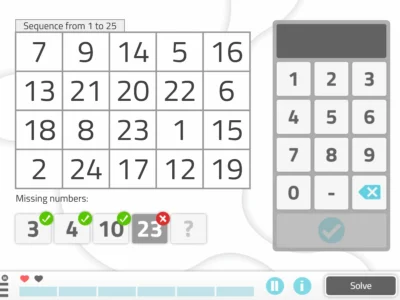Through this article we will delve into executive functions in children and adolescents, with special mention of ADHD and difficulties in executive functions.
In addition, you will learn a series of strategies to stimulate and promote the proper development of executive functions in children.
Executive functions in children
Over the last 20 years, interest has grown in understanding and deepening how to work on executive functions in children and adolescents, mainly to study the consequences and relationship with psychopathological disorders both in childhood and in adulthood.
We can understand executive functions as: “Complex mental activities necessary to plan, organize, guide, review, regulate and evaluate the behavior needed to adapt effectively to the environment and to achieve goals.” (Bauermeister, 2008).
Considering this definition, we can realize the importance they have in the early years, childhood and adolescence, and how a deficit or problem in these executive functions will cause children difficulties in that effective and necessary adaptation to the environment.
Problems in executive functions
Although problems in executive functions do not in themselves constitute a disability, we must not forget the consequences they can have in children’s daily lives.
It is important to clarify that there is no relation with the child’s intellectual capacity. People with superior intelligence can present difficulties in executive functions.
In children and adolescents, deficits in executive functions could be observed in the following behaviors:
- Impulsive and distractible traits.
- Disorganized task execution.
- Inhibition deficits.
- Difficulty leaving one activity and moving on to another.
- Problems choosing between two opposing tasks.
- Difficulty controlling the execution of a task.
- Difficulties in problem solving (PS).
- Need for constant instructions.
Problems associated with EF difficulties in children
Attention Deficit Hyperactivity Disorder (ADHD)
Children with ADHD exhibit deficits in executive functions such as planning, impulse control, attention and working memory, among others. In addition, executive functions develop more slowly.
It is estimated that 30% of people with ADHD have problems with their executive functions.
Executive function training in children with ADHD has been shown to be one of the most effective tools when intervening in the problem.
Learning difficulties (dyslexia, dyscalculia…)
Studies have shown the relationship that exists between learning problems and limitations in executive functions in children and adolescents.
Children with learning difficulties and ADHD may present a more disruptive executive dysfunction.
Fetal Alcohol Syndrome (FAS): Studies show that children who were exposed to alcoholic beverages during pregnancy present learning problems, greater difficulties in memory and various executive functions.
Acquired brain injury: Acquired brain injury, specifically in the frontal and prefrontal structures of the child’s brain, correlates with deficits in executive functions such as flexibility, self-regulation, planning and decision-making.
How to work on executive functions in children and adolescents
- The emotional dictionary
This exercise to improve executive functions consists of using a dictionary to look up words that express emotions. For example, with A: Joy, anxiety….
Once it is found, the child has to write the definition on a blank sheet of paper and give a concrete example of how the child experiences that emotion.
On the one hand, we are working on executive functions, but on the other hand, it is also especially useful for working on abilities such as self-regulation, planning and inhibition, helping the child to know themselves better.
- “Simon says…”
This game is an activity you can practice both individually and with groups of children. The game consists of one of the children being Simon, and what Simon says the others must do; if they do not, they are eliminated.
It begins with the “Simon says” phase so that the action is carried out. Be careful! If the child playing Simon says an action without first saying “Simon says”, that action should not be performed.
For example, the child playing Simon says “Simon says… everyone clap once”. In this case the other children must clap. However, if the child playing Simon says “Everyone clap once”, no one should do it because they did not say “Simon says” first.
This activity enhances sustained attention, inhibitory control, stimulus discrimination, following instructions and self-monitoring.
- Music
Music is a perfect ally to boost the development of executive functions in children and adolescents. Dancing, singing, or playing any instrument promotes the development of various functions, such as the ability to improvise, cognitive flexibility, working memory and inhibition.
- I.D.E.A.R Method
This method is especially recommended for children and adolescents with ADHD, although anyone can benefit from putting it into practice to improve their executive functions. The I.D.E.A.R method is a great tool for problem solving. It consists of:
- Identify the problem
Identify the problem concisely. For example, “I failed the Natural Sciences exam.”
- Define the problem
In this step you must describe it in detail, and a good strategy is to ask yourself a question and answer it: “Why did I fail the Natural Sciences exam? Because I did not study enough and I got very distracted while I was doing it.”
- Develop alternatives to solve the problem
- Next time I will study using outlines.
- I will prepare in advance for the next exam.
- Apply the designed plan
The next time the child has to face an exam, they will have already assessed and weighed what caused them to fail the previous one, and will have chosen the strategies they will carry out to prevent it from happening again.
- Reflect
In the last step the child must review all the steps they followed and evaluate the result. As they practice this method, little by little they will internalize it (At first it is normal that they need help) and put it into practice almost automatically, which results in a strengthening of executive functions.
- Interactive activities with NeuronUP
Thanks to the rise of new technologies, professionals have the best tools at hand to work on executive functions with children, adolescents and adults. With NeuronUP children can train executive functions guided by the neuropsychologist or occupational therapist who supervises them.
TAKE CARE OF YOUR BRAIN, AND HAVE FUN!
If you liked this article about executive functions in children and adolescents, you might also be interested in:
“This article has been translated. Link to the original article in Spanish:”
Funciones ejecutivas en niños y adolescentes







 7 Activities to Do in the Classroom with Elementary School Children with ADHD
7 Activities to Do in the Classroom with Elementary School Children with ADHD
Leave a Reply